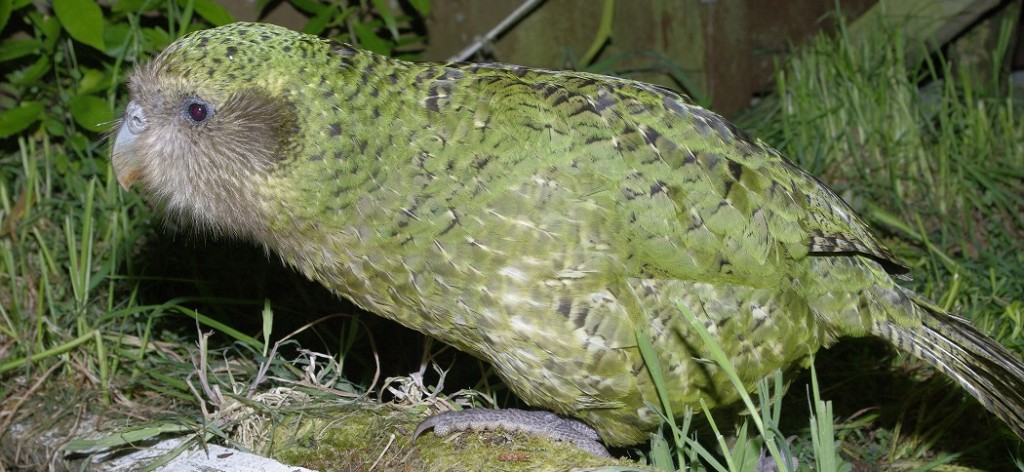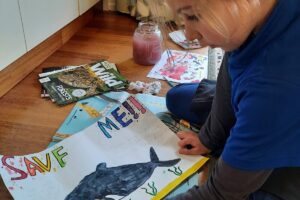A special group of people look after the last 125-or-so kākāpō left on Earth – working round the clock to save the species from extinction. Kākāpō were almost wiped out by introduced predators. Now they live wild on only two offshore islands: Whenua Hou (Codfish Island) and Puke Nui (Anchor Island).

Sirocco the kākāpō on Maud Island (Photo by Phil Brown).
The Kākāpō Recovery team includes DOC rangers, scientists, and a force of enthusiastic volunteers. Breeding season is extra busy for them. Each bird, each nest, and each new egg is a precious treasure.
Solo mums
One way kākāpō are different from a lot of birds is that they don’t form pairs to raise their chicks.
The males gather together to put on shows for the females, who then choose which male they will mate with. This is called lek breeding.
The females lay anything from one to four eggs. They make their nests, incubate their eggs, and raise their chicks all on their own … Well, with some help from the Kākāpō Recovery team.
The busy season
Kākāpō need a lot of energy for breeding, so team members put out extra food for them at special feeding stations, and occasionally weigh the birds to make sure they’re eating enough.
The kākāpō rangers keep a keen eye out for signs that any female kākāpō are nesting. Whenever it looks like one is, they hunt for her nest and put a video camera in it. They set up a camp nearby with a video screen. Using this nest-cam system, they can watch each nest carefully and deal quickly with any problems that crop up.
If it looks like a mum isn’t able to incubate an egg for some reason, the rangers take the egg to an incubation room at their base, where they keep it at just the right temperature and humidity to hatch.
Team members also hand-rear any chicks who can’t be looked after by their mums – feeding them every two hours.
Ruapuke
In 2014, a mother kākāpō named Lisa accidentally crushed her egg, probably by stepping on it.
A volunteer nest-minder noticed on the nestcam that there was something strange about the egg, and radioed a ranger to come and check.
The ranger took the egg back to base and fixed it up with tape and glue. The team was nervous. Because of the damage, germs could easily get into the egg, and make the embryo inside sick. They incubated it extra carefully.
Amazingly, the chick hatched by itself and grew into a healthy male bird – Ruapuke. He made news all around the world!
Night-time nest checks
Meet Jenny Rickett. She’s one of the rangers looking after the kākāpō colony on the island sanctuary, Whenua Hou.
She has to do a lot of her work during the night. Every evening, kākāpō mums leave their nests, and set off to gather food for their chicks. A mum can be away from the nest for anything from half an hour to three hours, depending on how old her chick is and how much food she needs to find for it.
This is Jenny’s chance to check nests. She normally checks two or three in a night, then sleeps at a camp near the last one.
If the nest is just new, she makes sure it’s safe and dry for the egg or chick. If there’s anything wrong with the nest, she fixes it up herself.
She checks each chick’s breathing rate and weight. She makes sure its eyes, mouth and nose are healthy and clean, and its poo looks normal.
Sometimes she and the other rangers have to switch chicks between kākāpō mums. For example, if a mum has two chicks, and isn’t finding enough food for both, the rangers might give one chick to a mum whose egg didn’t hatch.
To move a chick to a new mum’s nest, Jo carries it in an insulated container with air-holes and a heat pad in the bottom. She puts the chick into the new nest while the mum is away, then watches on the nest-cam to make sure the mum accepts the chick.
Did you know?
When kākāpō chicks hatch, their four toes all point forward. As they grow, two of their toes move to point backwards, so they can grip and perch. It’s thought that having all four toes pointing forward is more comfortable for them while they’re still in the egg.
When the chicks are close to fledging, they’re often bigger than their mothers.
When kākāpō chicks are little, they back up a few steps, then sneeze just before they poo!
This article was originally featured in the spring issue of KCC’s Wild Things Magazine. If you would like to receive a copy of your own, please consider joining us.
Join Now








1 Comment
Leave your reply.